We don’t usually get crafty around here, but this is a special case. It seems that moth larvae have been busy in my closet, and the little bastards ate a couple of holes in (among other things) my favourite Merino wool sweater. Here’s their handiwork on Ms Perfect’s sweater.
It took a while to hunt down and kill every last member of their family (except for one, who I commanded to go and tell the others). With that done, the problem was: How to repair the damage? A lot of web pages will get you started on sewing and darning, but I’ve found an easier method that still looks good.
You’re going to need some felting needles. They’re like regular needles, but as you can see in the photo, they have a serrated edge.
You’ll also need a block of foam.
Sometimes craft stores have them, but I got this one from a store that sells foam rubber, like mattresses and such. They usually have a lot of off-cuts for cheap (or even free), and a small cube will do.
I’m going to demonstrate on this wool blanket. That’s a big hole there.
First, put the foam block under the woolen material.
Now, you’ll need the felting needles. Pull the fabric together so that bits on either side of the hole are sort of close to each other. Then, use the needles to pull the individual threads closer to each other, and push the needle into the wool and the foam block. It makes a satisfying scrunching sound.
What you are doing is using the needles to tangle the woolen threads together, and turn them into a lovely snarl that will cover the hole. Keep doing it over and over. Be sure to pull the wool off the foam block every once in a while so the wool doesn’t get stuck to it.
If you keep it up, eventually all that wool will weave together and cover the hole, like this.
With care, it can be done on fabrics of a finer weave. Your strategy here will be to use a finer needle, drag individual fibers together, and scrunch them together to form a mesh. Here’s the sweater from earlier.
Just try to avoid overdoing it — it might take on the appearance of a puff-ball. When you start, try experimenting on some inconspicuous part of the sweater, or on one you don’t care so much about.
Here’s a close-up of the moth-eaten bit from my favourite sweater. It’s very strong, and you can hardly see where the hole was.


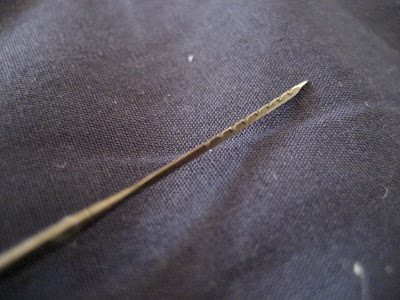
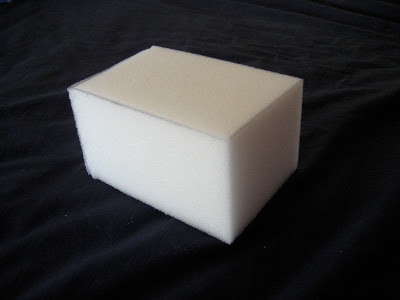
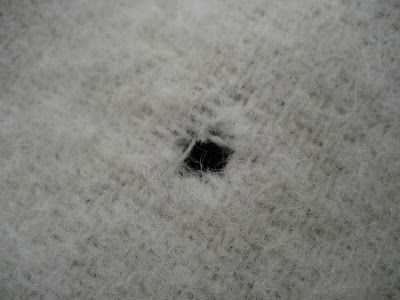
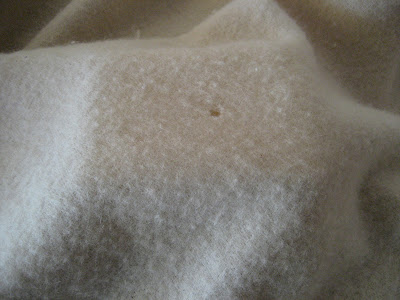
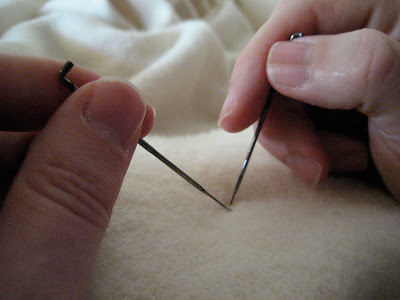
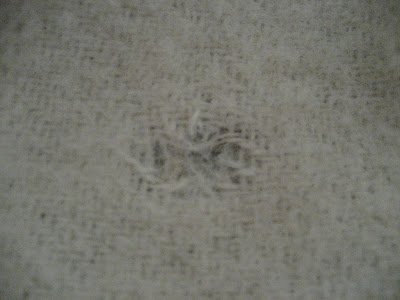
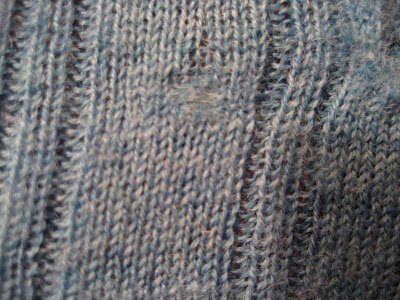
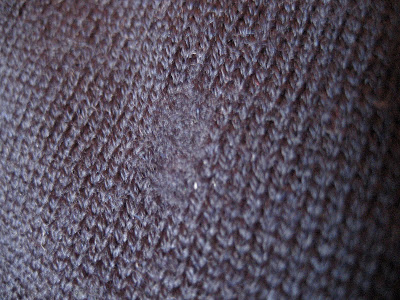
9 April 2012 at 9:15 pm
hi there,
I am giving this a go right now on a fine(ish) wool jumper and seem to only be able to get the fluff to aesthetically cover the hole… is the finished result usually sturdy? or could you poke your finger through it quite easily?
Im guessing I am just getting it wrong.
thanks:)
11 April 2012 at 5:59 am
It's like that at first, but the more you tangle the threads the better. Just keep checking the results from a distance to make sure it looks okay, especially with the fine stuff.
I find it's sturdier on my big hairy sweaters and blankets because I can go to town on them without worrying about the aesthetics of it.
If you're having doubts, stop and go with a traditional darning job.
12 April 2012 at 4:52 pm
Great, thanks Daniel.
yes I can see how it would work better with a thicker knit.
its a cleaver way to disguise the hole anyway. I will keep on and as you say, if it doesnt work out I will try another way.
cheers!
5 June 2013 at 5:43 am
good man. It is very help full for me and all people who need this repair this type damage.
Thanks,
16 September 2013 at 1:11 pm
Daniel, this was also my remedy to the moth problem, but for bigger holes I've patched with a little unspun wool. Easy to find at felting and spinning suppliers and even big box craft stores like Spotlight. Can go with a contrasting colour a-la TomOfHolland's visable darning project (http://tomofholland.com/)
More importantly, how did you get rid of the bastards?
16 September 2013 at 1:16 pm
I dry cleaned everything. It costs a bit, but it's an investment, and it does the trick.
I've heard they sneak a ride in on clothing brought in from elsewhere, so make sure not to store a sweater from the thrift store (say) until it's been cleaned.
30 August 2014 at 5:07 pm
I just bought a *gorgeous* wool sweater by Anthropologie for $15 (!) at an upscale consignment store, knowing it had 2-3 small moth holes. It came home in a plastic bag and went straight to the freezer. I haven't looked up this method yet (if it's even a "method") but we had our first encounter with head lice last fall and A LOT of stuff went in the freezer for 24 hours (and that IS a proven method for head lice.)
I'm wary of dry cleaning chemicals so I figured I'd give this a go. I also thought of heat, but I don't know what temperature and for how long it would take to kill the bastards. Maybe a microwave would do the trick? I don't know if it would affect the wool though…
As for preventing them, I've stuffed my toddlers stray socks with dried peppermint, pennyroyal, and lavender and it seems to keep them away. I also regularly mix white vinegar with peppermint & lavender essential oils to mist over my wool rugs.
12 November 2015 at 4:47 pm
Cedar is a good moth repellent. A good way is to put shavings in one of those little drawstring fabric bags. At one point I had them in every drawer & they hang by the strings on hooks or hangers in the closet. Cloves are also very effective. I have mixed whole cloves with the cedar shavings…smells so much better than moth balls. I have also mixed in clove oil, but you have to be careful not to let the bag touch any clothes, the oil will seep through the bag a little. For a really bad infestation the glue type traps work wonderful and are not harmful. They have a natural little bait that the moths are attracted to. Have you ever seen the dried up old oranges with cloves stuck in them? I actually made one once, smelled so good & insects don't like citrus either. I think once I have Wool-lited all of my favorite vintage sweaters, I'm going to put them into zip-locks. Good Luck & thanks everyone for all of the good ideas on repairing.
2 January 2015 at 3:07 pm
I have a very old and very thick, heavy quilt from Iowa that now has holes in it. Maybe caused from moths but can also be caused by earwigs–that once they get in your house you seem to have them forever and travel with you! Anyway, I only think I could mend the holes on the top. It is made from beautiful wool which appears to have been old mens suites or overcoats. Very unusual and hand stitched. I need to find someone with room in a freezer. Thanks for the idea.